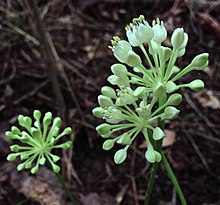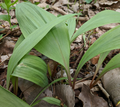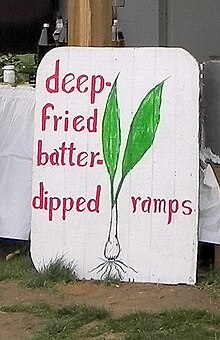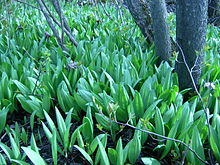Allium tricoccum
| Allium tricoccum | |
|---|---|

| |

| |
| Leaves and flowers | |
| Scientific classification | |
| Kingdom: | Plantae |
| Clade: | Tracheophytes |
| Clade: | Angiosperms |
| Clade: | Monocots |
| Order: | Asparagales |
| Family: | Amaryllidaceae |
| Subfamily: | Allioideae |
| Genus: | Allium |
| Species: | A. tricoccum
|
| Binomial name | |
| Allium tricoccum | |
| Synonyms[1] | |
|
show
Synonymy | |
Allium tricoccum (commonly known as ramp, ramps, ramson, wild leek, wood leek, or wild garlic)[2][3] is a North American species of wild onion widespread across eastern Canada and the eastern United States.[1] Many of the common English names for this plant are also used for other Allium species, particularly the similar Allium ursinum, which is native to Europe and Asia.
Description[]
Allium tricoccum is a perennial growing from an ovoid-conical shaped bulb that is 2–6 cm long.[4] Plants typically produce a cluster of 2–6 bulbs that give rise to broad,[5] flat, smooth, light green leaves, that are 20–30 cm long including the narrow petioles,[4] often with deep purple or burgundy tints on the lower stems. The bulbs are white and surrounded by brownish to grayish sheathing. Each cluster of bulbs gives rise to one flowering stem.[5] The flowers are arranged into an umbel that has an erect scape that is typically 10–40 cm long.[6] The inflorescence has two ovate bracts that enclose the flowers before they open and fall away at anthesis.[4] The flowering stem is persistent after fruiting. The flowering most commonly occurs after the leaves have died back, unlike the similar Allium ursinum, in which leaves and flowers can be seen at the same time. Ramps grow in close groups strongly rooted just beneath the surface of the soil.[7] Flowering occurs in June or July into August. The flowers have white, cream or yellowish tepals which are 4–7mm long.[5] The stamens are about as tall as the tepals and the filaments of the stamens have widened bases and are inserted on the corolla. After flowering and fertilization green fruits are produced that are three-lobed and open by way of three valves.[4] The seeds are round, black, and shiny.[5][8]
Taxonomy[]
Allium tricoccum was first named as such in 1789 by the Scottish botanist William Aiton, in Hortus Kewensis, a catalog of plants cultivated in London's Kew botanic garden. The species had been introduced to Britain in 1770. The specific epithet tricoccum refers to the possession of three seeds.[9]
- Varieties
As of November 2018, Kew's Plants of the World Online accepts two varieties:[10]
- Allium tricoccum var. tricoccum
- Allium tricoccum var. burdickii Hanes—narrow-leaf ramps,[11] white ramps,[11] Chicago leek,[12] Burdick's leek[13]
This treatment is followed by other sources,[14][5][15] although the two taxa are frequently treated as two species, Allium tricoccum and Allium burdickii.[11][12][13][16][17] A. tricoccum var. burdickii was first described by Clarence Robert Hanes in 1953; the epithet burdickii is in honor of Justin Herbert Burdick (1851–1939), a Midwestern physician and manufacturer who pointed out differences between what were then regarded as different "races" in letters to Asa Gray.[18][12] The variety was raised to a full species by Almut Gitter Jones in 1979.[19]
The two varieties are distinguished by several features.[5][11] A. tricoccum var. tricoccum is generally larger than A. tricoccum var. burdickii: the bulbs are larger, the leaves are usually 5–9 cm (2.0–3.5 in) wide rather than 2–4 cm (0.8–1.6 in) wide and the umbels typically have 30–50 flowers rather than 12–18. Additionally, the leaf stalks (petioles) and leaf sheaths are usually red or purplish in var. tricoccum and white in var. burdickii. The leaves of var. burdickii also have less distinct stalks than those of var. tricoccum.[5][11][12]

var. tricoccum

var. burdickii
Habitat[]
Allium tricoccum is found in woods with rich soils with moist ground in depressions, and along streamside bluffs, and on colluvial slopes.[20] Allium tricoccum var. burdickii is found growing in dry soils of upland woods.[21]
Conservation[]
In Canada, ramps are considered rare delicacies. Since the growth of ramps is not as widespread there as in Appalachia and because of human activity, ramps are a threatened species in Quebec. Allium tricoccum is a protected species under Quebec legislation. A person may have ramps in his or her possession outside the plant's natural environment, or may harvest it for the purposes of personal consumption in an annual quantity not exceeding 50 bulbs or 50 plants, provided those activities do not take place in a park within the jurisdiction of the National Parks Act. The protected status also prohibits any commercial transactions of ramps; this prevents restaurants from serving ramps as is done in the United States. Failure to comply with these laws is punishable by a fine.[22] However, the law does not always stop poachers, who find a ready market across the border in Ontario (especially in the Ottawa area), where ramps may be legally harvested and sold.[23]
Ramps are considered a species of "special concern" for conservation in Maine, Rhode Island, and commercially exploited in Tennessee.[24]
Common name[]
According to West Virginia University botanist Earl L. Core, the widespread use in southern Appalachia of the term "ramps" (as opposed to "wild leek" which is used in some other parts of the United States) derives from Old English:
The name ramps (usually plural) is one of the many dialectical variants of the English word ramson, a common name of the European bear leek (Allium ursinum), a broad-leaved species of garlic much cultivated and eaten in salads, a plant related to our American species. The Anglo-Saxon ancestor of ramson was hramsa, and ramson was the Old English plural, the –n being retained as in oxen, children, etc. The word is cognate with rams, in German, Danish, Swedish, and Norwegian, and with the Greek kromuon, garlic [...]. Wright’s English Dialect Dictionary (1904) lists as variants rame, ramp, ramps, rams, ramsden, ramsey, ramsh, ramsies, ramsy, rommy, and roms, mostly from northern England and Scotland.[3]
Culinary uses and festivals[]


Allium tricoccum is popular in the cuisines of the rural uplands of its native region. Both the white lower leaf stalks and the broad green leaves are edible. It is regarded as an early spring vegetable with a strong garlic-like odor and a pronounced onion flavor.[25] Ramps also have a growing popularity in restaurants throughout North America.[26][27][28]
The plant's flavor, a combination of onions and strong garlic,[29][30][31] is adaptable to numerous cooking styles. In central Appalachia, ramps are most commonly fried with potatoes in bacon fat or scrambled with eggs and served with bacon, pinto beans and cornbread. Ramps can also be pickled or used in soups and other foods in place of onions and garlic.[32]
- The community of Richwood, West Virginia, holds the annual "Feast of the Ramson" in April. Sponsored by the National Ramp Association, the "Ramp Feed" (as it is locally known) brings thousands of ramp aficionados from considerable distances to sample foods featuring the plant. During the ramp season (late winter through early spring), restaurants in the town serve a wide variety of foods containing ramps.[33]
- The city of Elkins, West Virginia, hosts the "Ramps and Rails Festival" during the last weekend in April of each year. This festival features a cook-off and ramp-eating contests, and is attended by several hundred people each year.[34]
- The town of Cosby, Tennessee, bordering Great Smoky Mountains National Park, has held the largest and one of the oldest ramp festivals in the United States, the "Cosby Ramp Festival," on the first weekend in May since 1954. The festival has played host to as many as 30,000 visitors in years past, has been attended by ex-President Harry Truman, and has featured such notable musical acts as Tennessee Ernie Ford, Eddy Arnold, Roy Acuff, Bill Monroe, Minnie Pearl, and Brenda Lee. Besides the food, heritage music, dancing, and adulation of the ramp, each year a young woman is crowned "Maid of Ramps".[35]
- The community of Flag Pond, Tennessee, hosts its annual Ramp Festival on the second Saturday each May. The festival features a wide variety of ramp-inspired foods, and includes music from an assortment of Appalachian groups. Hundreds of people attend the festival each year.[36]
- The community of Whitetop, Virginia, holds its annual ramp festival the third weekend in May. It is sponsored by the Mount Rogers volunteer fire department and features local music from Wayne Henderson and other bands, along with a barbecued chicken feast complete with fried potatoes and ramps and local green beans. A ramp-eating contest is held for children and adults.[37]
- An annual ramp convention in Haywood County, North Carolina, has drawn as many as 4,000 participants a year since its inception circa 1925.[38]
- The community of Huntington, West Virginia, holds an annual ramp festival referred to as Stink Fest. It is hosted by The Wild Ramp, an indoor farmers market.[39][40]
- The Mason-Dixon park in Greene County, Pennsylvania holds an annual ramp festival at the Mason-Dixon Park towards the end of April. There are various ramp delicacies, as well as music, crafts, vendors, and more.[citation needed]
- The Mason-Dixon Historical Park in Core, West Virginia offers a Ramp Dinner and Wildflower Walk each spring.[citation needed]
History and folklore[]
Chicago received its name from a dense growth of ramps near Lake Michigan in Illinois Country observed in the 17th century. The Chicago River was referred to by the plant's indigenous name, according to explorer Robert Cavelier, sieur de La Salle, and by his comrade, the naturalist and diarist Henri Joutel.[25] The plant, called shikaakwa (chicagou) in the Miami-Illinois language spoken by the local indigenous Miami people, was once thought to be Allium cernuum, the nodding wild onion, but research in the early 1990s showed the correct plant was the ramp.[25][41][42][43]
The ramp has strong associations with the folklore of the central Appalachian Mountains. Fascination and humor have fixated on the plant's extreme pungency. Jim Comstock, editor and co-owner of the Richwood News Leader, introduced ramp juice into the printer's ink of one issue as a practical joke,[44] invoking the ire of the U.S. Postmaster General.[45]
The inhabitants of Appalachia have long celebrated spring with the arrival of the ramp, believing it to be a tonic capable of warding off many winter ailments. Indeed, ramp's vitamin and mineral content did bolster the health of people who went without many green vegetables during the winter.[46]
Native American ethnobotany[]

Cuisine[]
The Menominee,[47] Cherokee,[48][49][50] Iroquois,[51] Potawatomi[52] and Ojibwa[52] all consume the plant in their traditional cuisines.
Medicinal use[]
The Cherokee also eat the plant as a spring tonic, for colds and for croup. They also use the warm juice for earaches.[49] The Ojibwa use a decoction as a quick-acting emetic.[53] The Iroquois also use a decoction of the root to treat worms in children, and they also use the decoction as a spring tonic to "clean you out".[54] Some Native Americans also used juice from the crushed bulbs to treat insect stings.[55]
See also[]
- Allium cepa, also known as calçot
- Allium ursinum, also known as ramson
- Campanula rapunculus, also known as rampion bellflower
References[]
- ^ Jump up to: a b c "Allium tricoccum". World Checklist of Selected Plant Families (WCSP). Royal Botanic Gardens, Kew. Retrieved 24 May 2014.
- ^ "Allium tricoccum". Germplasm Resources Information Network (GRIN). Agricultural Research Service (ARS), United States Department of Agriculture (USDA). Retrieved 2 February 2012.
- ^ Jump up to: a b Core, Earl L. (15 April 1973). "Cult of the Ramp Eaters". Charleston Gazette-Mail. Reprinted in the same author's book: Core, Earl L. (1975). The Wondrous Year: West Virginia Through the Seasons. Grantsville, West Virginia: Seneca Books. pp. 46–51.
- ^ Jump up to: a b c d Gleason, Henry A. (Henry Allan), 1882-1975. (1963). Manual of vascular plants of Northeastern United States and adjacent Canada. Cronquist, Arthur. Princeton, N.J. p. 203. ISBN 0-442-02722-2. OCLC 243396.CS1 maint: multiple names: authors list (link)
- ^ Jump up to: a b c d e f g McNeal Jr., Dale W.; Jacobsen, T.D. (2002). "Allium tricoccum". In Flora of North America Editorial Committee (ed.). Flora of North America North of Mexico (FNA). 26. New York and Oxford. Retrieved 21 August 2016 – via eFloras.org, Missouri Botanical Garden, St. Louis, MO & Harvard University Herbaria, Cambridge, MA.
- ^ "Allium tricoccum - FNA". beta.floranorthamerica.org. Retrieved 3 January 2021.
- ^ "Cultivation of Ramps". North Carolina State University. Archived from the original on 26 March 2014. Retrieved 19 February 2014.
- ^ "Wild Leek (Allium tricoccum)". www.illinoiswildflowers.info. Retrieved 20 March 2021.
- ^ Aiton, William (1789). Hortus Kewensis. 1. Printed for George Nicol, Bookseller to his Majesty. p. 428.
- ^ "Allium tricoccum". Plants of the World Online. Royal Botanical Gardens Kew. Retrieved 6 November 2018.
- ^ Jump up to: a b c d e Weakley, Alan S. (2018), Flora of the Southern and Mid-Atlantic States, working draft of 20 August 2018, University of North Carolina Herbarium, North Carolina Botanical Garden, University of North Carolina at Chapel Hill
- ^ Jump up to: a b c d Wilhelm, Gerould; Rericha, Laura (2017). Flora of the Chicago Region: A Floristic and Ecological Synthesis. Indiana Academy of Sciences.
- ^ Jump up to: a b "Allium burdickii". wwx.inhs.illinois.edu. Illinois Natural History Survey. Retrieved 6 November 2018.
- ^ "Search for Allium tricoccum". World Checklist of Selected Plant Families. Royal Botanic Gardens, Kew. Retrieved 24 May 2014.
- ^ "Allium burdickii". Integrated Taxonomic Information System. Retrieved 21 August 2016.
- ^ Reznicek, A. A.; Voss, E. G.; Walters, B. S., eds. (February 2011). "Allium burdickii". Michigan Flora Online. University of Michigan Herbarium. Retrieved 6 November 2018.
- ^ "Comprehensive Report Species - Allium burdickii". explorer.natureserve.org. NatureServe. Retrieved 6 November 2018.
- ^ Hough, Michael (2004). "Allium tricoccum". Plants of the Northeastern United States. Retrieved 30 July 2018.
- ^ Jones, Almut G. (1979). "A Study of Wild Leek, and the Recognition of Allium burdickii (Liliaceae)". Systematic Botany. 4 (1): 29–43. doi:10.2307/2418663. JSTOR 2418663.
- ^ "Allium tricoccum var. tricoccum in Flora of North America @ efloras.org". www.efloras.org. Retrieved 30 December 2020.
- ^ "Allium tricoccum var. burdickii in Flora of North America @ efloras.org". www.efloras.org. Retrieved 30 December 2020.
- ^ "Regulation respecting threatened or vulnerable plant species and their habitats". Gazette officielle. Éditeur officiel du Québec. 1 May 2014. Retrieved 19 May 2014.
- ^ "Garlic lovers answer the call of the wild". Globe and Mail. 21 May 2007. Retrieved 19 May 2014.
- ^ "Allium tricoccum". Natural Resources Conservation Service PLANTS Database. USDA. Retrieved 22 January 2018.
- ^ Jump up to: a b c Zeldes, Leah A. (5 April 2010). "Ramping up: Chicago by any other name would smell as sweet". Dining Chicago. Chicago's Restaurant & Entertainment Guide, Inc. Archived from the original on 11 May 2011. Retrieved 2 May 2010.
- ^ Hugh Merwin (23 April 2013). "How Ramps Became Spring's Most Popular, and Divisive, Ingredient". Grubstreet. Retrieved 21 August 2016.
- ^ Adam Martin (20 April 2012). "Cult of Ramps Begins Worship Season Early". The Wire. Retrieved 21 August 2016.
- ^ William Porter (23 April 2014). "Ramps: How to cook and where to find this savory spring treat". Denver Post. Archived from the original on 26 April 2014. Retrieved 21 August 2016.
- ^ Block, Eric (2010). Garlic and Other Alliums: The Lore and the Science. Cambridge, UK: Royal Society of Chemistry. ISBN 978-0-85404-190-9.
- ^ Davies, Dilys (1992). Alliums: The Ornamental Onions. Portland: Timber Press.
- ^ Woodward, Penny (1996). Garlic and Friends: The History, Growth and Use of Edible Alliums. South Melbourne: Hyland House.
- ^ "Ramps: How to Forage & Eat Wild Leeks". Foraging for Wild Edibles. Retrieved 10 May 2021.
- ^ "Ramp Festivals, Feast of the Ramson Ramps". Retrieved 17 February 2013.
- ^ "Ramps & Rails Festival". West Virginia Department of Commerce. Archived from the original on 20 April 2011. Retrieved 17 February 2013.
- ^ "Cosby Ramp Festival". Tennessee Vacation. Archived from the original on 12 March 2013. Retrieved 17 February 2013.
- ^ "Flag Pond, Unicoi County, Tennessee". Retrieved 26 October 2011.
- ^ "Whitetop Mountain Ramp Festival". Grayson County, VA website. Archived from the original on 30 September 2011. Retrieved 17 February 2013.
- ^ Core 1975, p. 51.
- ^ "The Wild Ramp". 5 August 2016. Retrieved 21 August 2016.
- ^ Rebekah Pewitt (18 April 2015). "Stink Fest Brings Big Crowds to the Huntington's West End". Retrieved 21 August 2016.
- ^ Swenson, John F. (Winter 1991). "Chicago: Meaning of the Name and Location of Pre-1800 European Settlements". Early Chicago. Retrieved 11 July 2021.
- ^ https://upchicago.wordpress.com/2010/12/29/shikaakwa-shikako-checagou-chicago-the-origins-of-the-name-chicago/
- ^ http://heritagegarden.uic.edu/shikaakwa
- ^ Miller, Tom D. (5 October 2012). "Jim Comstock". West Virginia Encyclopedia. Retrieved 17 February 2013.
- ^ "Ramps in the Ink". Goldenseal. 20: 23. Winter 1994. Comstock had been inspired by the scratch-and-sniff advertising for perfume and coffee in several local papers. The issue in question announced the Richwood Ramp Supper by lacing the printer's ink for the spring issue with ramp juice. According to Comstock, "We got a reprimand from the Postmaster General ... And we are probably the only paper in the United States that's under oath to the federal government not to smell bad".
- ^ Davis, Jeanine M.; Greenfield, Jacqulyn. "Cultivating Ramps: Wild Leeks of Appalachia". Purdue University. Archived from the original on 10 May 2011. Retrieved 6 May 2011.
- ^ Smith, Huron H. 1923 Ethnobotany of the Menomini Indians. Bulletin of the Public Museum of the City of Milwaukee 4:1-174 (p. 69
- ^ Witthoft, John 1977 Cherokee Indian Use of Potherbs. Journal of Cherokee Studies 2(2):250-255 (p. 251)
- ^ Jump up to: a b Hamel, Paul B. and Mary U. Chiltoskey 1975 Cherokee Plants and Their Uses -- A 400 Year History. Sylva, N.C. Herald Publishing Co. (p. 52)
- ^ Perry, Myra Jean 1975 Food Use of "Wild" Plants by Cherokee Indians. The University of Tennessee, M.S. Thesis (p. 47)
- ^ Waugh, F. W. 1916 Iroquis Foods and Food Preparation. Ottawa. Canada Department of Mines (p. 118)
- ^ Jump up to: a b Smith, Huron H. 1933 Ethnobotany of the Forest Potawatomi Indians. Bulletin of the Public Museum of the City of Milwaukee 7:1-230 (p. 104)
- ^ Densmore, Frances 1928 Uses of Plants by the Chippewa Indians. SI-BAE Annual Report #44:273-379 (p. 346)
- ^ Herrick, James William 1977 Iroquois Medical Botany. State University of New York, Albany, PhD Thesis (p. 281)
- ^ Niering, William A.; Olmstead, Nancy C. (1985) [1979]. The Audubon Society Field Guide to North American Wildflowers, Eastern Region. Knopf. p. 595. ISBN 0-394-50432-1.
Further reading[]
- Core, Earl Lemley (December 1945). "Ramps". Castanea 10(4):110–112. JSTOR 4031395.
- Davies, D. (1992). Alliums: The Ornamental Onions. Portland: Timber Press. ISBN 978-0-88192-241-7.
- Facemire, Glen (2009). Having your ramps and eating them too. Parsons, WV: McClain Printing. ISBN 978-0-87012-783-0.
- Woodward, P. (1996). Garlic and Friends: The History, Growth and Use of Edible Alliums. South Melbourne: Hyland House. ISBN 978-1-875657-62-9.
- Allium
- Flora of Eastern Canada
- Flora of the Eastern United States
- Ephemeral plants
- Leaf vegetables
- Perennial vegetables
- Plants described in 1789
- History of Chicago
- Plants used in Native American cuisine
- Plants used in traditional Native American medicine
- Taxa named by Almut Gitter Jones
- Taxa named by William Aiton



